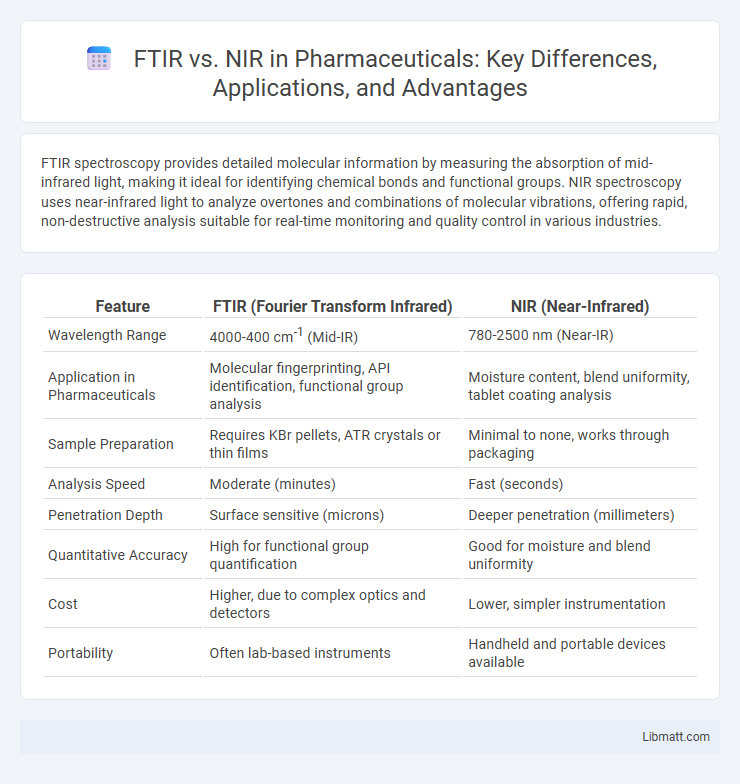FTIR spectroscopy provides detailed molecular information by measuring the absorption of mid-infrared light, making it ideal for identifying chemical bonds and functional groups. NIR spectroscopy uses near-infrared light to analyze overtones and combinations of molecular vibrations, offering rapid, non-destructive analysis suitable for real-time monitoring and quality control in various industries.
Table of Comparison
| Feature | FTIR (Fourier Transform Infrared) | NIR (Near-Infrared) |
|---|---|---|
| Wavelength Range | 4000-400 cm-1 (Mid-IR) | 780-2500 nm (Near-IR) |
| Application in Pharmaceuticals | Molecular fingerprinting, API identification, functional group analysis | Moisture content, blend uniformity, tablet coating analysis |
| Sample Preparation | Requires KBr pellets, ATR crystals or thin films | Minimal to none, works through packaging |
| Analysis Speed | Moderate (minutes) | Fast (seconds) |
| Penetration Depth | Surface sensitive (microns) | Deeper penetration (millimeters) |
| Quantitative Accuracy | High for functional group quantification | Good for moisture and blend uniformity |
| Cost | Higher, due to complex optics and detectors | Lower, simpler instrumentation |
| Portability | Often lab-based instruments | Handheld and portable devices available |
Introduction to FTIR and NIR Spectroscopy
FTIR (Fourier Transform Infrared) spectroscopy analyzes the mid-infrared region to identify molecular vibrations and chemical bonds in samples, providing detailed structural information. NIR (Near-Infrared) spectroscopy examines the near-infrared range, often used for rapid, non-destructive analysis of overtones and combination bands related to molecular vibrations in organic compounds. You can choose FTIR for precise molecular characterization, while NIR offers quicker, bulk compositional analysis in various industries.
Fundamental Principles of FTIR and NIR
Fourier Transform Infrared (FTIR) spectroscopy operates by measuring the absorption of mid-infrared light, causing molecular vibrations that correspond to fundamental vibrational modes within a sample's chemical bonds. Near-Infrared (NIR) spectroscopy, in contrast, relies on overtone and combination bands primarily involving C-H, O-H, and N-H bonds, using shorter wavelengths that penetrate deeper and allow rapid, non-destructive analysis. Understanding these fundamental principles helps you choose the appropriate technique based on the molecular information and sample depth required for your specific application.
Key Differences Between FTIR and NIR
FTIR (Fourier Transform Infrared) spectroscopy primarily measures mid-infrared light absorption, providing detailed molecular fingerprinting and chemical structure information, while NIR (Near-Infrared) spectroscopy analyzes overtones and combinations of molecular vibrations, enabling rapid and non-destructive analysis of samples. FTIR offers higher spectral resolution and sensitivity to functional groups, making it ideal for qualitative analysis, whereas NIR excels in quantitative analysis and process monitoring due to its deeper sample penetration and minimal sample preparation. Key differences include the spectral range (FTIR: 4000-400 cm-1, NIR: 14000-4000 cm-1), sample interaction depth, and typical applications in laboratory versus industrial settings.
Advantages of FTIR Spectroscopy
FTIR spectroscopy offers superior spectral resolution and detailed molecular fingerprinting compared to NIR, enabling precise identification of complex chemical compounds. Its ability to analyze a wide range of sample types, including solids, liquids, and gases, makes it highly versatile across various industries like pharmaceuticals and materials science. The technique's sensitivity to functional groups and vibrational modes enhances quantitative and qualitative analysis, providing comprehensive chemical characterization.
Advantages of NIR Spectroscopy
NIR spectroscopy offers rapid, non-destructive analysis with minimal sample preparation, making it ideal for in-line and real-time monitoring in industrial processes. Its deeper penetration depth allows for bulk sample assessment, providing more representative data compared to the surface-sensitive FTIR technique. The ability of NIR to analyze moisture, fat, protein, and other organic compounds swiftly enhances productivity and quality control in food, pharmaceutical, and agricultural sectors.
Typical Applications of FTIR
FTIR spectroscopy is typically used for identifying functional groups, analyzing polymer composition, and detecting contaminants in pharmaceuticals. It excels in measuring molecular vibrations and chemical bonding in organic and inorganic materials. Common applications include quality control, forensic analysis, and monitoring chemical reactions.
Common Uses of NIR in Industry
NIR spectroscopy is widely used in industries such as agriculture, pharmaceuticals, and food processing for rapid, non-destructive analysis of moisture, protein, and fat content. Its ability to provide real-time quality control and process monitoring enhances manufacturing efficiency and product consistency. You can rely on NIR technology for precise, on-site measurements that reduce reliance on time-consuming traditional laboratory methods.
Sample Preparation: FTIR vs NIR
FTIR spectroscopy typically requires more extensive sample preparation, including pellet pressing or thin film creation, to ensure accurate IR light transmission and absorbance measurement. NIR spectroscopy demands minimal or no sample preparation, allowing direct analysis of solids, liquids, or powders due to its deeper penetration and reliance on overtone and combination bands. This difference significantly impacts analysis speed and ease, making NIR preferable for rapid, non-destructive testing in industrial processes.
Limitations and Challenges of Each Method
FTIR spectroscopy faces limitations in analyzing water-rich samples due to strong absorption bands, which can interfere with spectral interpretation and reduce accuracy. NIR spectroscopy struggles with lower sensitivity and specificity, often requiring complex calibration models to interpret overlapping overtone and combination bands. Your choice between FTIR and NIR should consider these challenges in sample type and data processing requirements to ensure reliable results.
Choosing Between FTIR and NIR: Which Is Best?
FTIR spectroscopy provides detailed molecular fingerprinting and high-resolution analysis, making it ideal for complex chemical identification and structural elucidation. NIR spectroscopy offers rapid, non-destructive analysis with deep penetration and excellent suitability for moisture, fat, and protein quantification in agricultural and pharmaceutical samples. Selection between FTIR and NIR depends on application-specific requirements such as sample type, speed, resolution, and the depth of chemical information needed.
FTIR vs NIR Infographic

 libmatt.com
libmatt.com